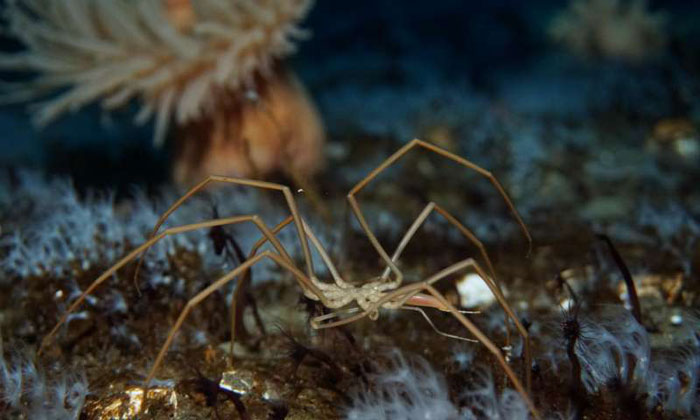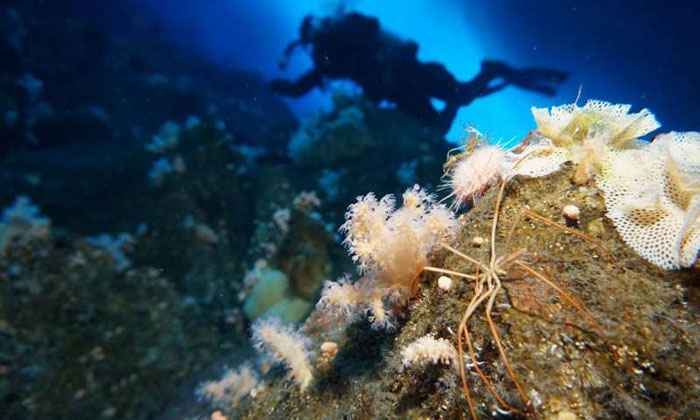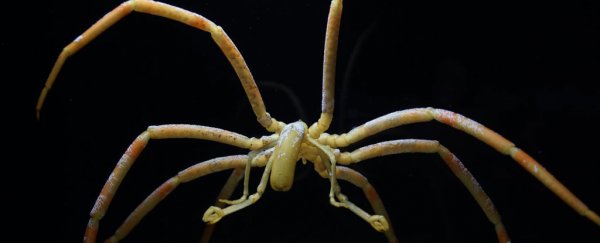Biology students will tell you that a beating heart is how the body pumps blood and circulates oxygen, but with fairness, educators never considered a freakish exception to the rule: the sea spider.
These unusual ocean dwellers – which despite their name, aren't actually arachnids at all – get by with a unique alternative, using their guts as a pump to move oxygen around their spindly bodies, in place of the vital organ keeping the rest of us alive right now.
This newly discovered ability may sound like an abnormal evolutionary solution – but then again, sea spiders aren't exactly ordinary organisms, with almost all of their body footprint made up by their disturbingly slender legs.
Accordingly, it's within these pin-like limbs, explains biologist H. Arthur Woods from the University of Montana, that the sea spider has had to adapt to carry out vital metabolic functions.
 Timothy R. Dwyer (PolarTREC 2016), Courtesy of ARCUS
Timothy R. Dwyer (PolarTREC 2016), Courtesy of ARCUS
"Unlike us, with our centrally located guts that are all confined to a single body cavity, the guts of sea spiders branch multiple times and sections of gut tube go down to the end of every leg," says Woods.
"In effect, sea spiders guts are 'space-filling' and ubiquitous in their bodies in the same way that our circulatory systems are space-filling and ubiquitous."
But while it was already known that sea spiders' branching guts were housed within their legs, up until now nobody knew that this complex stomach system was also moonlighting as a kind of underwater pacemaker.
While in Antarctica studying polar gigantism – the phenomenon of polar species having larger bodies than their counterparts in warmer climates – Woods noticed something amiss about the sea spiders in his research.
While sea spiders do have a beating heart, Woods observed that it only beats weakly, seemingly incapable of pumping blood outside of the animal's central torso (or thorax).
Instead, it seemed like the mechanism of gut peristalsis – in which waves of muscle constriction and relaxation occur inside the stomach – appeared to be stepping in to do the heart's job.
 Timothy R. Dwyer (PolarTREC 2016), Courtesy of ARCUS
Timothy R. Dwyer (PolarTREC 2016), Courtesy of ARCUS
"My 'aha!' moment was to consider that maybe all that sloshing of blood and guts was not about digestion but instead about moving respiratory gases around," Woods says.
To confirm the hypothesis, Woods and his team collected specimens of 12 sea spider species from Antarctica and the west coast of the US, and injected their blood with a chemical dye.
When manipulating the animals' oxygen supply – lowering the amount of oxygen in their water, effectively forcing them to work harder to breathe – the researchers noticed the guts' peristaltic motions stepped up accordingly, much like the human heart rate goes up when we exercise.
The researchers say it's possible other marine creatures might be using the same breathing apparatus, but point out that we don't know yet how this unique evolution came about: either the branching leg guts adapted to allow respiration first, or they originally evolved for digestion purposes, with the circulation following after.
Future research and fossil discoveries may have an answer for that one day, but in the meantime the sea spider's crazy leg-gut-heart hybrid serves as an expedient reminder of how life, uh, finds a way – using and repurposing whatever it can for survival.
"[Sea spiders] don't have any specialised structures for gas exchange," one of the team, marine ecologist Amy Moran from the University of Hawaii at Manoa, explained to National Geographic.
"We have lungs. Fish have gills. Sea spiders don't have anything except a large surface area."
The findings are reported in Current Biology.
